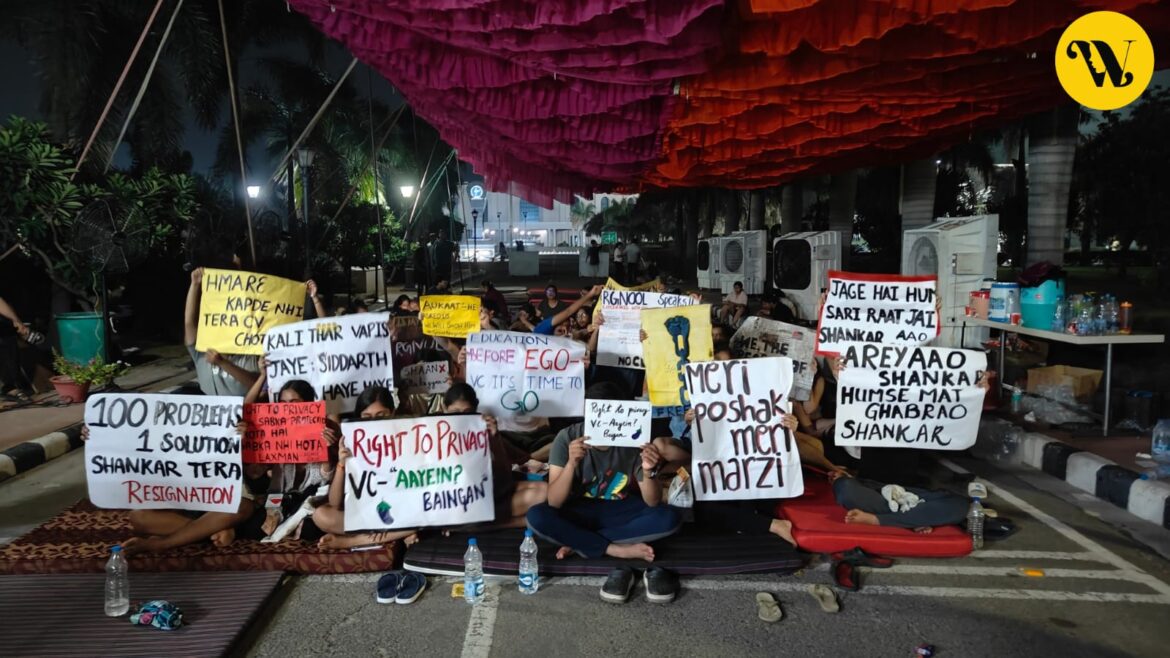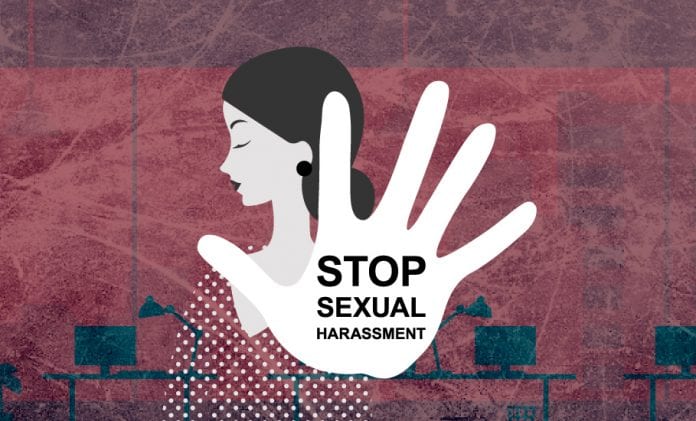Ground Report By Kashish Singh
Written Report By Parika Singh
“Courage calls to courage everywhere, and its voice cannot be denied.”
– Millicent Fawcett
The Rajiv Gandhi National University of Law (RGNUL) students, Patiala, became a testament to Fawcett’s words when they chose to stand together against their Vice-Chancellor (VC) this week. In the scorching heat, 400 students sat in a protest demanding resignation from the University VC citing his sexist remarks and orthodox approach toward students.
On Sunday, reports emerged that Dr. Jai Shankar Singh allegedly entered the women’s hostel and made inappropriate remarks to the female students inside their rooms. The student body, already aggrieved with his restrictive approach to critical thinking in academics, gender-based discrimination, and dismissal of safety and mental health concerns, was enraged by this invasion of privacy and unwarranted comments on their clothes, activities, and personal possessions.
The students made a representation before Justice Sheel Nagu, Hon’ble Chief Justice of Punjab and Haryana High Court, and Chancellor of RGNUL, seeking the removal or resignation of the VC based on his actions. The letter sent on September 23, showcased a pattern of objectionable behaviour throughout his tenure and highlighted a prior show cause notice received by him as Dean of Law, Allahabad University, for visiting a faculty member after working hours and making objectionable statements.
The egregious response of the administration toward this situation was also questioned when they suddenly shut down the campus instead of initiating a proper investigation through its Internal Complaints Committee (ICC).
The Womb spoke to the protesting students on the ground. Students were petrified of coming forward to the press for fear of repercussions from the administration.
A student hiding their identity using an umbrella said, “At around 2 PM on Sunday, VC Sir entered the girls’ hostel in the pretext of a regular check without any prior intimation. Many girls didn’t want him to enter the rooms but he still did and asked unwarranted questions.”
Students alleged this wasn’t the first incident and Dr. Jai Shankar had repeatedly violated students’ privacy by making un-called-for remarks vis-à-vis students’ financial conditions or personal emergencies. His problematic approach wasn’t limited to students but also targeted female staff members, guards, and faculty members.
Unfortunately, this was not the first case of sexual harassment in Indian law schools that garnered limelight in recent times. It was not even the first one this year. In May, a bench headed by the Hon’ble Chief Justice of Gujarat High Court Ms. Sunita Agarwal took strong exception to the lack of action taken by the Registrar of Gujarat National Law University (GNLU), Gandhinagar, against allegations of discrimination, rape, homophobia, and suppression of voices made by the students. The order warned,
“Not a single incident disturbing the freedom of expression of any student (within the framework of law) or suppression of voice on any social and legal issue shall be tolerated.”
Later that month, the Calcutta High Court directed the ICC of the West Bengal National University of Juridical Sciences (WBNUJS), Kolkata, to examine the sexual harassment complaint of a faculty against its VC which was dismissed as time-barred by the committee. With notable similarity to the students of RGNUL, the Student Juridical Association of WBNUJS wrote to their Chancellor, the Hon’ble Chief Justice of India, to suspend the VC and prevent the Associate Professor from further harassment and threat.
The Calcutta High Court observed the “intimidating, offensive and hostile work environment” created by the VC for the complainant after allegedly sexually harassing her for over five years.
NLSIU Bangalore, NALSAR Hyderabad, National Law University Delhi, ILS Law College Pune, Symbiosis Hyderabad, it appears no university has remained unscathed from the horrors of sexual abuse by students, staff, or even the institutional heads. And these are just the prominent law schools in the country. Educational institutions of other disciplines fare no better. But Law Schools have a higher responsibility to uphold the rule of law and principles of justice for they nurture the future legal fraternity of the country to implement the same in their practices.
Naturally, their inability to foster an atmosphere of safety, non-discrimination, and transparency is concerning. It also raises a larger question on the efficacy of ICCs in handling such complaints.
The Vishakha judgment of the Supreme Court in 1997 opened the doors for protection against workplace sexual abuse in the country which led to the enactment of The Prevention of Sexual Harassment of Women at Workplace (POSH) Act in 2013. The scope of this Act was expanded to include Higher Educational Institutions through the University Grants Commission Regulation, 2015. It mandated the constitution of ICCs with a woman presiding officer, teaching and non-teaching staff, an NGO representative, and members of the student body.
All inquiries must be completed within 90 days and may result in expulsion or reformative punishment. Failure to adhere could result in the withdrawal of grants for the University and may also lead to revocation of affiliation or recognition by the government. Additionally, the Regulation also mandates periodic Gender and Sensitisation training on the campus as well as orientation programs for ICC members. Universities are also required to facilitate transportation, adequate security, and mental and physical health counsel within their premises.
However, the present cases make it clear that the mere formation of an ICC is not sufficient to address sexual harassment on campus. Inefficiency, political pressure, opaque mechanisms, fear of retribution, and double victimisation prevent harassment victims from approaching this forum in the first place. The few complaints made are often not treated with the privacy and sensitivity they deserve and rarely hold the accused accountable, particularly if they are in higher positions of authority such as Registrar or Vice-Chancellor.
In the past few years, incidents in both NLSIU and Symbiosis have come to light where student complainants were punished or suspended. But the decision to close down the entire university by RGNUL authorities in response to student complaints will set an unconstitutional precedent for universities to neglect their responsibilities under the POSH Act, discard freedom of speech and expression, and withhold education itself. It is hardly surprising that the data released by UGC on reported cases of sexual harassment in ICCs of National Law Universities is dismal at best.
| Sr. No. | University | Number of cases reported in 2019-2020 | 2020-2021 | 2021-2022 | 2022-2023 |
| 1) | RGNUL, Patiala | 2 | – | 3 | – |
| 2) | DSNLU, Visakhapatnam | 0 | – | – | – |
| 3) | GNLU, Gandhinagar | 3 | 0 | – | 0 |
| 4) | RMLNLU, Lucknow | 3 | – | – | – |
| 5) | HMNLU, Shimla | 0 | – | – | 3 |
| 6) | NUSRL, Ranchi | 0 | – | – | – |
| 7) | NUALS, Kerala | 0 | – | – | – |
| 8) | MNLU, Mumbai | 0 | – | – | – |
Of the 8 NLUs that submitted their reports in 2019-2020, only 3 of them repeated the endeavour in the next three years, RGNUL being one of them. Disappointingly, tier 1 law schools such as NLSIU Bangalore, NALSAR Hyderabad, NLU Delhi, and NUJS Kolkata did not appear to have submitted their data to the UGC despite its requirement in the 2015 Regulation. Outside the NLUs, data was reported by various branches of Symbiosis, UPES Dehradun, Nirma University, Ahmedabad, and O.P. Jindal Global University, Sonipat. Interestingly, Jindal reported the highest number of cases last year- 46, indicating an efficient and functional ICC in their institute.
The UGC has asked all universities to submit their data for the year 2023-2024. With the VCs of two major NLUs being implicated this year, will their ICCs accurately report the students’ concerns or attempt to stifle them?
Currently, students from RGNUL are protesting day and night on a darkened campus. They have not been permitted to speak to anyone outside their barricaded gates. In a democratic country inside an institution that teaches fundamental rights to them, their voices crave to reach a sympathetic ear. Laws and regulations can only serve their purpose if they are implemented. The POSH Act, 2013, and the UGC Regulations, 2015, make no exception for people in the highest positions of power. But the question remains, will those students be heard?






